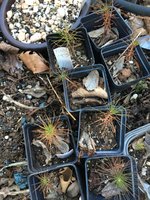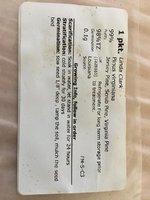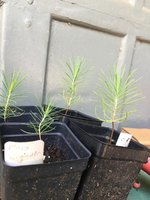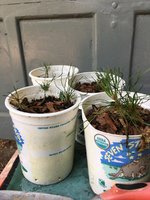You are using an out of date browser. It may not display this or other websites correctly.
You should upgrade or use an alternative browser.
You should upgrade or use an alternative browser.
Linda Clark’s lindapat pinus virginiana
- Thread starter LindaPat
- Start date
augustine
Chumono
If you're going to grow pines plant J Black pine and Scots pine. Scrub pine is OK but just ok, maybe (unless you can find a good trunk in the wild).
LindaPat
Mame
I was looking for something native to north america. And thinking that for a forest, these might be good. But I’m a novice. JBP seems very slow growing, too, for growing from seed. (I’m 72). I have a couple young Eastern white pine, and hear they are impossible, but probably good to practice the treatment of candles and bending and wiring, which seems so different from deciduous. Maybe I’ll plant scots pine seeds next year.
Kanorin
Omono
Nice. I love that a bunch of people are experimenting with native US pines. When did you plant the seeds?
augustine
Chumono
You're right, pine is slow (and you're not the only one thinking about age). You may be able to find more developed but young J. and Scots pines at Meehan's Miniatures in MD. Describe your vision to Ms. Meehan and ask for recommendations. I have nothing against VA pines except they are so slow.
Kudos!
Kudos!
Wires_Guy_wires
Imperial Masterpiece
There are a wide range of pines that do just as well, or even better. Depending on your location. P. Nigra, JRP, Mugo, Jack pine, Ponderosa, all can be done from seed and yield decent and/or good results in a 6-10 year timespan.If you're going to grow pines plant J Black pine and Scots pine. Scrub pine is OK but just ok, maybe (unless you can find a good trunk in the wild).
I believe there's no reason not to try a whole lot of different pines. As discussed before, there are even good examples - albeit a handfull - of eastern white pines. A species despised in most bonsai circles.
LindaPat
Mame
These mugo from seed are in their second summer. I wonder when to move them to bonsai soil. The first batch I grew from seed two years previously didn’t do well with transplant and only one survived.
So maybe I’ll try loblolly and jack pine next. I grew up in Texas. Loblolly everywhere, but maybe not so vigorous in philly.
So maybe I’ll try loblolly and jack pine next. I grew up in Texas. Loblolly everywhere, but maybe not so vigorous in philly.
Attachments
LindaPat
Mame
I always plant in winter, jan/feb, in clear plastic containers with drainage hole and air/water vent on top. Plants are chunky and nicely green when they come up in spring. Little greenhouses. These were winter planted in ‘21.Nice. I love that a bunch of people are experimenting with native US pines. When did you plant the seeds?
LindaPat
Mame
Sorry, ‘20.I always plant in winter, jan/feb, in clear plastic containers with drainage hole and air/water vent on top. Plants are chunky and nicely green when they come up in spring. Little greenhouses. These were winter planted in ‘21.
LindaPat
Mame
‘20 for mugo, ‘21 for virginiana.Sorry, ‘20.
LindaPat
Mame
Thanks for the advice about Meehan’s miniatures. I got 3 acer buer, and they are great with very nice roots and all. I’ll keep my eyes open for pines.You're right, pine is slow (and you're not the only one thinking about age). You may be able to find more developed but young J. and Scots pines at Meehan's Miniatures in MD. Describe your vision to Ms. Meehan and ask for recommendations. I have nothing against VA pines except they are so slow.
Kudos!
LindaPat
Mame
Uh oh. These little pinus virginiana look too much alike to be a tiny forest this year. Also seem to be suffering somehow. Thinking of gently transplanting next month into bonsai soil. Do I fertilize when they start growing with fertilizer for acid loving plants? I think I’ll transplant some with lots of room to grow, others in small groups or very small pots. 

Gabler
Masterpiece
That’s pretty normal for pine seedlings around here. They tend to dry out in the winter, but they usually bounce back once things warm up. Don’t try to compensate with extra water, since you’ll drown the roots.
Virginia pine is a colonizer species that thrives in disturbed areas. As such, I’ve found them to be fairly forgiving of neglect. That said, I have also yet to refine any into “finished” trees. I only just started working with them recently, so mine are still in development.
Loblolly pines are also vigorous growers in this area, and they respond well to root work. Unlike most pines, they can handle fairly harsh root pruning and also wet soil. That’s not a recommendation. Just that if you mess up, the tree should bounce back if you let it grow unrestrained for a while. The drawback of loblolly pine is that like other southern yellow pine species, the needles are long and the growth can be coarse. I can’t comment on how well the needles reduce because again, I’m still developing my loblolly pines.
Virginia pine is a colonizer species that thrives in disturbed areas. As such, I’ve found them to be fairly forgiving of neglect. That said, I have also yet to refine any into “finished” trees. I only just started working with them recently, so mine are still in development.
Loblolly pines are also vigorous growers in this area, and they respond well to root work. Unlike most pines, they can handle fairly harsh root pruning and also wet soil. That’s not a recommendation. Just that if you mess up, the tree should bounce back if you let it grow unrestrained for a while. The drawback of loblolly pine is that like other southern yellow pine species, the needles are long and the growth can be coarse. I can’t comment on how well the needles reduce because again, I’m still developing my loblolly pines.
LindaPat
Mame
Whew! Nice to know they may survive and are pretty tolerant of root disturbance. Hoping to grow some bigger than others. I was looking at pictures of forests in Peter Adam’s book, and sizes of trees seem quite different in them. Maybe I should plant more seeds next winter to have some very little ones.
Gabler
Masterpiece
Maybe I should plant more seeds next winter to have some very little ones.
A forest is generally most convincing with trees of varying sizes, and planting seeds is cheap and easy, so why not go for it?
That said, it’ll likely take a long time to get the trees to develop, so your best bet is to use your current seedlings as your smallest trees and pick up some larger Virginia pine either at a nursery or in the woods (or both).
LindaPat
Mame
You are right. Would be very miniature indeed.
Similar threads
- Replies
- 0
- Views
- 434
- Replies
- 7
- Views
- 665
- Replies
- 3
- Views
- 1K



